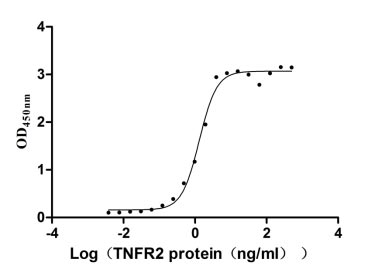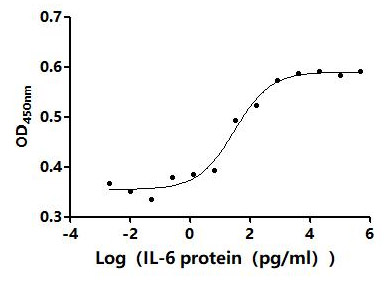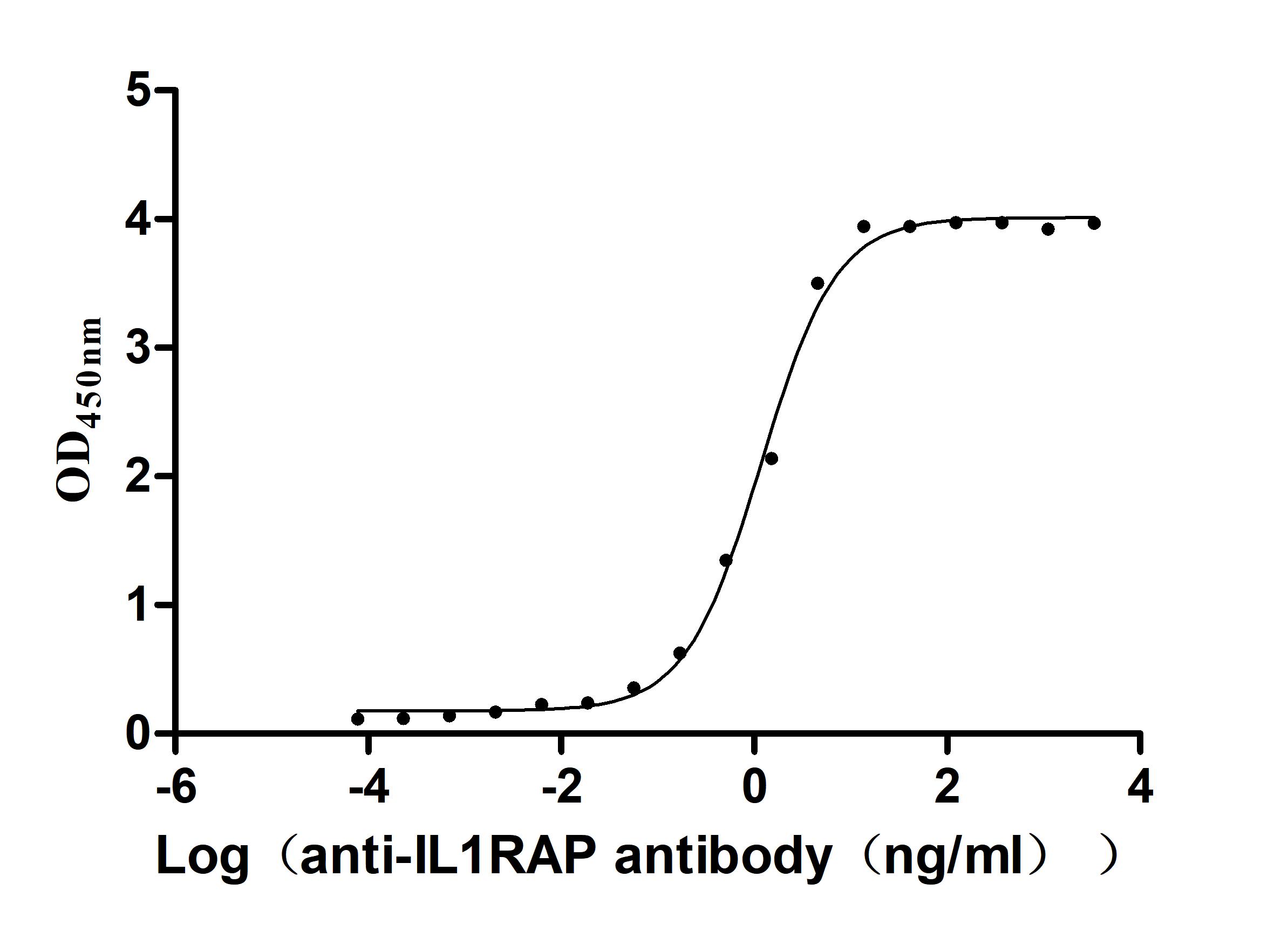Recombinant Rat Phosphoenolpyruvate carboxykinase, cytosolic [GTP] (Pck1)
-
中文名称:大鼠Pck1重组蛋白
-
货号:CSB-YP017613RA
-
规格:
-
来源:Yeast
-
其他:
-
中文名称:大鼠Pck1重组蛋白
-
货号:CSB-EP017613RA
-
规格:
-
来源:E.coli
-
其他:
-
中文名称:大鼠Pck1重组蛋白
-
货号:CSB-EP017613RA-B
-
规格:
-
来源:E.coli
-
共轭:Avi-tag Biotinylated
E. coli biotin ligase (BirA) is highly specific in covalently attaching biotin to the 15 amino acid AviTag peptide. This recombinant protein was biotinylated in vivo by AviTag-BirA technology, which method is BriA catalyzes amide linkage between the biotin and the specific lysine of the AviTag.
-
其他:
-
中文名称:大鼠Pck1重组蛋白
-
货号:CSB-BP017613RA
-
规格:
-
来源:Baculovirus
-
其他:
-
中文名称:大鼠Pck1重组蛋白
-
货号:CSB-MP017613RA
-
规格:
-
来源:Mammalian cell
-
其他:
产品详情
-
纯度:>85% (SDS-PAGE)
-
基因名:
-
Uniprot No.:
-
别名:Pck1; Phosphoenolpyruvate carboxykinase; cytosolic [GTP]; PEPCK-C; EC 4.1.1.32
-
种属:Rattus norvegicus (Rat)
-
蛋白长度:Full length protein
-
表达区域:1-622
-
氨基酸序列MPPQLHNGLD FSAKVIQGSL DSLPQEVRKF VEGNAQLCQP EYIHICDGSE EEYGRLLAHM QEEGVIRKLK KYDNCWLALT DPRDVARIES KTVIITQEQR DTVPIPKSGQ SQLGRWMSEE DFEKAFNARF PGCMKGRTMY VIPFSMGPLG SPLAKIGIEL TDSPYVVASM RIMTRMGTSV LEALGDGEFI KCLHSVGCPL PLKKPLVNNW ACNPELTLIA HLPDRREIIS FGSGYGGNSL LGKKCFALRI ASRLAKEEGW LAEHMLILGI TNPEGKKKYL AAAFPSACGK TNLAMMNPTL PGWKVECVGD DIAWMKFDAQ GNLRAINPEN GFFGVAPGTS VKTNPNAIKT IQKNTIFTNV AETSDGGVYW EGIDEPLAPG VTITSWKNKE WRPQDEEPCA HPNSRFCTPA SQCPIIDPAW ESPEGVPIEG IIFGGRRPAG VPLVYEALSW QHGVFVGAAM RSEATAAAEH KGKVIMHDPF AMRPFFGYNF GKYLAHWLSM AHRPAAKLPK IFHVNWFRKD KNGKFLWPGF GENSRVLEWM FGRIEGEDSA KLTPIGYVPK EDALNLKGLG DVNVEELFGI SKEFWEKEVE EIDKYLEDQV NADLPYEIER ELRALKQRIS QM
-
蛋白标签:Tag type will be determined during the manufacturing process.
The tag type will be determined during production process. If you have specified tag type, please tell us and we will develop the specified tag preferentially. -
产品提供形式:Lyophilized powder
Note: We will preferentially ship the format that we have in stock, however, if you have any special requirement for the format, please remark your requirement when placing the order, we will prepare according to your demand. -
复溶:We recommend that this vial be briefly centrifuged prior to opening to bring the contents to the bottom. Please reconstitute protein in deionized sterile water to a concentration of 0.1-1.0 mg/mL.We recommend to add 5-50% of glycerol (final concentration) and aliquot for long-term storage at -20℃/-80℃. Our default final concentration of glycerol is 50%. Customers could use it as reference.
-
储存条件:Store at -20°C/-80°C upon receipt, aliquoting is necessary for mutiple use. Avoid repeated freeze-thaw cycles.
-
保质期:The shelf life is related to many factors, storage state, buffer ingredients, storage temperature and the stability of the protein itself.
Generally, the shelf life of liquid form is 6 months at -20°C/-80°C. The shelf life of lyophilized form is 12 months at -20°C/-80°C. -
货期:Delivery time may differ from different purchasing way or location, please kindly consult your local distributors for specific delivery time.Note: All of our proteins are default shipped with normal blue ice packs, if you request to ship with dry ice, please communicate with us in advance and extra fees will be charged.
-
注意事项:Repeated freezing and thawing is not recommended. Store working aliquots at 4°C for up to one week.
-
Datasheet :Please contact us to get it.
靶点详情
-
功能:Cytosolic phosphoenolpyruvate carboxykinase that catalyzes the reversible decarboxylation and phosphorylation of oxaloacetate (OAA) and acts as the rate-limiting enzyme in gluconeogenesis. Regulates cataplerosis and anaplerosis, the processes that control the levels of metabolic intermediates in the citric acid cycle. At low glucose levels, it catalyzes the cataplerotic conversion of oxaloacetate to phosphoenolpyruvate (PEP), the rate-limiting step in the metabolic pathway that produces glucose from lactate and other precursors derived from the ...显示更多
-
基因功能参考文献:
- Peroxynitrite-induced coronary vascular dysfunction may be mediated, at least in part, through increased expressions and activities of RhoA, ROCK1, and ROCK2. PMID: 27724862
- GBS can reduce blood glucose in T2DM rats while improving glucose tolerance and hyperglycemia, and the mechanism appears to be associated with a decrease of hepatic PEPCK mRNA and protein expression. PMID: 26681041
- PEPCK is downregulated and has a role in reduction of blood glucose and gluconeogenesis after phenobarbital administration in rats PMID: 26348778
- It observed lower expression of hepatic PEPCK mRNA, in the magnesium-deficient rats, thus suggesting a possible compensatory mechanism to diminish glycogenesis. A low-magnesium diet alters glucocorticoid metabolism, which leads to endothelial damage. PMID: 23015202
- Leptin activates NOS III and induces nitric oxide that nitrates PEPCK-C to reduce its level and glyceroneogenesis. PMID: 22808220
- The increase of protein intake during pregnancy could decrease the expression of y acid synthetase and PEPCK mRNA, and prevent offspring from high-fat diet-induced obesity in adult. PMID: 19548567
- retinoic acid response element 2 in rat Pck1 promoter is responsible for transcriptional activation by retinoic acid PMID: 21519922
- In addition to increased transcription rate, a gestational high fat diet resulted in modifications of the Pck1 histone code in livers of offspring. PMID: 21486814
- Pck1 plays an important role in both the mammary gland adipocytes and epithelial cells during lactation PMID: 21504969
- During acute hepatic failure severe endotoxemia damages the function of gluconeogenesis in livers and kidneys by inhibiting transcription of PEPCK. PMID: 17903369
- Taken together, our results suggest that, during very demanding exercise, muscle-derived interleukin-6 could help increase hepatic glucose production by directly upregulating PEPCK mRNA abundance. PMID: 19850730
- Expression of the PEPCK gene in H4IIEC3 rat hepatoma cells is closely coordinated with cell proliferation. PMID: 11820793
- increased PEPCK gene transcription at acid pH required a cis-acting element (enhancer) in the more distal 5' flanking region of the promoter PMID: 11939717
- polyunsaturated and nonmetabolized FAs stimulate adipose PEPCK, therefore potentially enhancing glyceroneogenesis and reducing FA output. This mechanism could participate in the hypolipidemic action of PUFAs. PMID: 11968005
- promoter context may influence which domains within a transcription factor are employed to mediate transactivation of PEPCK PMID: 12237288
- transcription of the gene for phosphoenolpyruvate carboxykinase (GTP) in the liver is regulated by SREBP-1c and Sp1 PMID: 14744869
- PEPCK transcription induced by protein kinase A is regulated by CREB and C/EBP. PMID: 15604115
- SHARP-2 is a potential repressor of PEPCK gene expression PMID: 15733865
- Hepatic PEPCK gene expression is modulated by chronic exercise training. PMID: 16458327
- Pck1 is up-regulated during liver gluconeogenesis. PMID: 17158265
- Endogenous lipid molecules induce PEPCK-C gene transcription and attenuate insulin action in liver. PMID: 17678617
- Comparison of the Mn2+-OAA-Mn2+GDP and Mn2+-Mn2+GTP structures illustrates a marked difference in the bound conformations of the nucleotide substrates in which the GTP nucleotide is bound in a high-energy state. PMID: 17685635
- Suppression of phosphoenolpyruvate carboxykinase gene expression by reduced endogenous glutathione level PMID: 17964299
- The effects of several variants of retinoic acid on the expression and activity of PEPCK in human, mouse, and rat adipose tissue are reported. PMID: 18492826
- structural data are consistent with a model in that the energy input from substrate association results in changes in the free energy landscape for the protein, allowing for structural transitions along an induced fit pathway PMID: 18772387
- skeletal muscle PEPCK has a role in determining physical activity levels PMID: 19521512
- Expression of the rat PEPCK gene in adipose tissue requires a PPAR-gamma/RXR binding site located 1 kbp upstream of the promoter. Similar elements are in the human and mouse gene. PMID: 10224131
- In white adipose tissue, overexpression causes obesity without diabetes, while underexpression causes lipodystrophy and perhaps insulin resistance. PMID: 12409311
- PEPCK catalyzes a key step of gluconeogenesis and glyceroneogenesis. It is expressed at significant levels in liver, kidney, intestine, white and brown adipose tissues, and lactating mammary gland. Control is mainly at transcription. PMID: 9242918
- PEPCK is a key enzyme of glyceroneogenesis in adipocytes and hepatocytes. Glyceroneogenesis produces glycerol-3-P to control the triglyceride/fatty acid cycle. PMID: 12788931
- The first cAMP response element (CRE) was discovered upstream of the rat PEPCK gene. PMID: 3015903
- Expression of the rat PEPCK gene in adipose tissue requires a PPAR-gamma/RXR binding site located 1 kbp upstream of the promoter. Similar elements are in the human and mouse gene. PMID: 10224131
收起更多
-
亚细胞定位:Cytoplasm, cytosol. Endoplasmic reticulum.
-
蛋白家族:Phosphoenolpyruvate carboxykinase [GTP] family
-
数据库链接:



-AC1.jpg)














